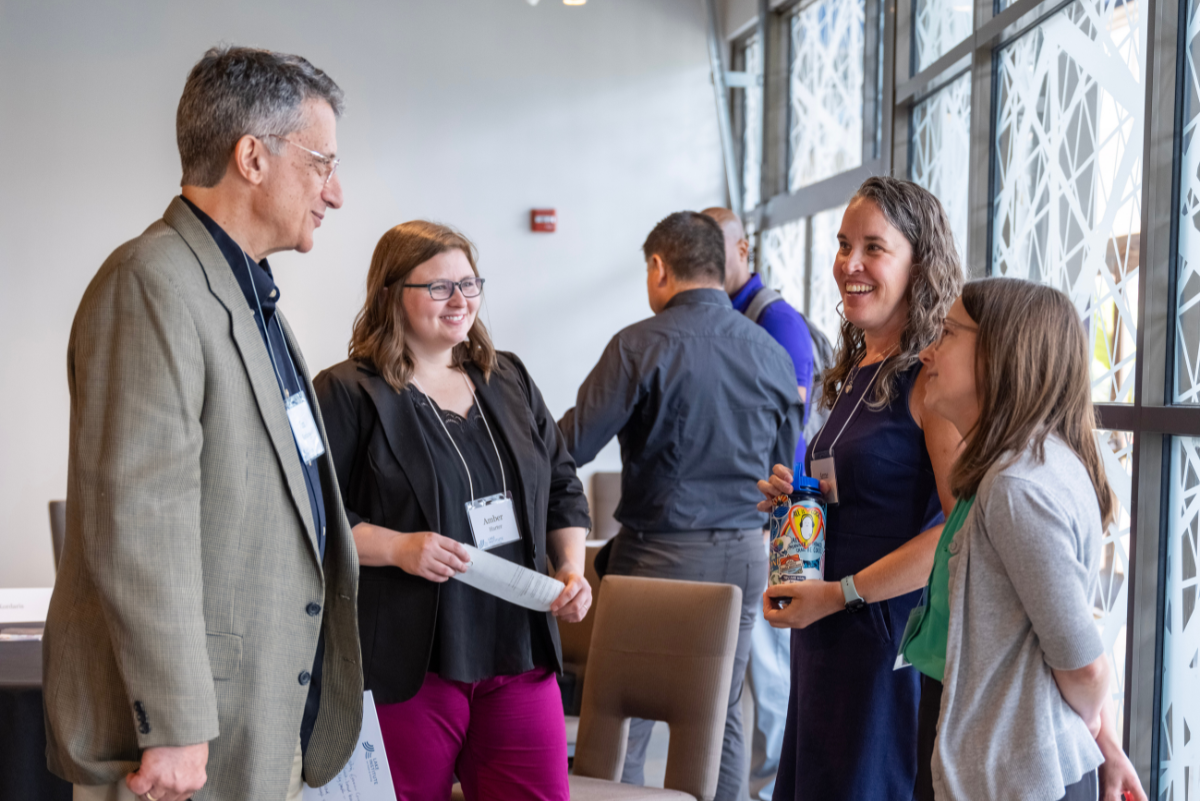Who Wants to Fund Us? Rethinking Fundraising Through Relationships and the Constituency Model
Who Wants to Fund Us? Rethinking Fundraising Through Relationships and the Constituency Model
By Meredith McNabb, Associate Director of Education, Lake Institute on Faith & Giving
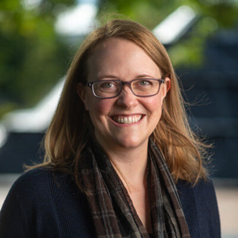
“So, we’re trying to find a grant to cover replacing our HVAC—do you know anyone who funds that kind of thing?”
“We’ve had go-to givers for decades: anytime we needed something, they made it happen. How do we go about finding new people like that?”
These are only very slight exaggerations of what we’ve heard from leaders in religious organizations grappling with questions of resources and donors—and the answers are never as simple as people sometimes seem to be hoping. But how can religious organizations identify and engage with people and philanthropic organizations who could join with them in accomplishing the good work that they do?
Kerry Robinson, in her book Imagining Abundance, describes early difficulties she had in this work when she first served as a professional fundraiser. Even though she was working alongside a beloved and gifted clergyperson for a cause they were both passionate about, they weren’t connecting with donors, and they were getting more and more frustrated. Upon reflection, she writes:
“We realized that we were unwittingly viewing donors as objects to try to get as much money from as quickly and painlessly as possible, rather than as subjects in their own right. Donor prospects are not objects; they are subjects, and like all of us, they want to contribute to something meaningful and life-giving and successful. Like us, they too search for meaning, have fears and hopes, desires and regrets, and beliefs that should be acknowledged and reverenced.”
Identifying and successfully engaging potential new donors or funders is never going to be flipping a switch; it takes time, trust, and relationship to find meaningful points of connection and partnership.
But there are some strategies to get started in a way that’s likely to bear fruit—and they’re not, as one not-very-helpful fundraising adviser once proclaimed at a conference: “Well, just look around your community: who are the millionaires you could ask to make a gift?” There are better—and more realistic!—approaches to take.
A key strategy is to think through the different constituencies in your organization’s orbit: who are you connected with, and how do they know you—and what might be a meaningful next step in relating to each of those constituencies?
The Constituency Model
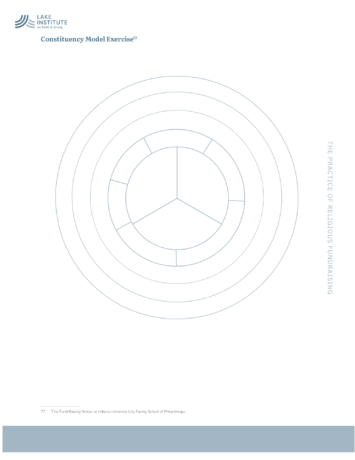 Lake Institute’s colleagues in the Lilly Family School of Philanthropy, The Fund Raising School, have long taught the concept of the Constituency Model: Thinking of your organization or congregation, who are the individuals and groups of people who know the very most about your organization and who are the very most central to your success through their leadership, advocacy, or funding? Those constituencies go in the very center—they might be your board members, your deeply committed major donors, and your executive director or senior clergy.
Lake Institute’s colleagues in the Lilly Family School of Philanthropy, The Fund Raising School, have long taught the concept of the Constituency Model: Thinking of your organization or congregation, who are the individuals and groups of people who know the very most about your organization and who are the very most central to your success through their leadership, advocacy, or funding? Those constituencies go in the very center—they might be your board members, your deeply committed major donors, and your executive director or senior clergy.
Next, which individuals or groups know a whole lot and are very important to your success as an organization? Those constituencies go in the next ring. Staff, core volunteers, perhaps former board members, and others might make up this layer for your setting.
Moving out ring by ring, which groups or people know some things about your organization and are pretty important to accomplishing your work? Which groups or individuals know a little about you, but don’t presently really impact your work? Which groups or individuals don’t know much of anything about you, but share some common interests with you—perhaps they share a religious tradition with you, or they have a passion for similar causes as your organization, or they might literally be your neighbors?
Finally, at the outer edge, you’ve got groups and individuals who don’t know your organization and don’t have any particular common interests, but they’re in your community or your region—The Fund Raising School notes this group as “Your Organization’s Universe.”
Strategic Questions
Developing this model can be an instructive process: organizations sometimes realize that there are hidden constituencies they’ve overlooked, constituencies they’ve taken for granted, and even constituencies they’ve overestimated in terms of how central and connected they are to the core of the organization’s work. Ideally, though, the model then gives leaders the chance to be strategic:
What kinds of information might be meaningful to catch the attention of a particular constituency group?
(Alumni of a school want and need to hear about some different things than the parents of current students do, for instance—and alumni from the past ten years likely care about different things than alumni from 40 years ago.)
What kinds of causes might be compelling to different constituency groups?
(The neighbors of a congregation are unlikely to be very moved to contribute to its HVAC repair fund but might be interested in gifts to support community-centered projects like feeding the hungry or rebuilding a shared playground.)
What kinds of opportunities to give might interest different constituency groups?
(Committed major donors and past and present board members might be at a point where they’d like to consider capital campaign contributions or planned gifts, while community partners with some shared interests might be more likely to co-sponsor a 5k fun run or a festival.)
The Constituency Model is one tool to help segment one’s givers for the sake of engaging with them thoughtfully and feasibly. Some congregations and religious organizations struggle with the idea of treating different givers differently—they don’t want to fall into a trap of catering to major givers and ignoring more modest contributors and friends—and some get overwhelmed by the idea of trying to relate to all people in all ways. This model can help leaders to broaden their approach to segmentation around different groups of potential givers if that’s unfamiliar for them, but it also makes the work more manageable. Focusing on one constituency (or a few related ones) at a time can spark imagination and even reduce time and costs as leaders can choose appropriate strategies for appropriate groups.
Identifying and successfully engaging new donors and funders will never be effortless—and it shouldn’t be, if it’s going to yield real relationships!—but this is a tool that can move the work forward more smoothly and effectively, and it recognizes the whole network of connections and shared interests that each organization and congregation has across its own collection of constituency groups.
From Vision to Impact: A Relational Approach to Faith-Based Fundraising
By Tiffany Bennett-Cornelous, Ph.D., Pastor of Worship, Arts & Media at Macedonia New Life Church in Raleigh, North Carolina
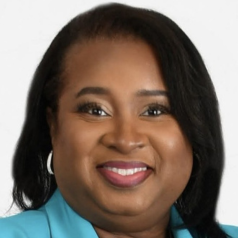
Religious fundraising does not have to be a daunting undertaking. The commonly cited adage, “It’s not what you know, but who you know,” holds merit and is a great description of the Constituency Model of fundraising. What you need to know is that connections matter. A key insight of this model is the critical importance of leveraging relational networks.
The Constituency Model of fundraising uses a strategic approach to identify stakeholders when planning a fundraising campaign. We used this fundraising model during a campaign to close the gap of projected annual income. The campaign had two objectives: (1) Close the gap to maintain operating expenses for the rest of the year, and (2) replace funds used from another campaign with a different focus. The project aimed to ensure continued growth, outreach, and service with the provision to meet financial obligations, service consistency, and long-term goals. Initially, we needed to get a sense of who we should include in the project, and the Constituency Model helped us strategically roll out the vision and plan. The cultivation of deeper relationships with both internal stakeholders and members of the broader community was an unanticipated yet significant outcome of the initiative.
While the constituency focus was on the internal organizational members as primary donors, it was evident that their contributions alone would be insufficient. It was necessary to launch the project to include a broader perspective. The organizational leader, members, the board, and the management team were central to the fundraising project’s initial communication. As a member of the leadership team, it was paramount that we all led in the fundraising goal in generous giving above our planned giving. Our next step involved identifying and engaging the employees, recipients of our outreach programs, and community members who would help with the fundraising goal.
The success of our fundraising campaign underscored the power and practicality of the Constituency Model. The intentional strategy to mobilize our internal and external networks deliberately facilitated our ability to identify critical financial goals while reinforcing our community ties. This model reminded us that effective fundraising is not just about asking for money—it’s about cultivating relationships, casting a shared vision, and engaging every layer of our community with purpose. When done strategically and collaboratively, religious fundraising becomes not only achievable but transformative for everyone involved.
Staff Reading List
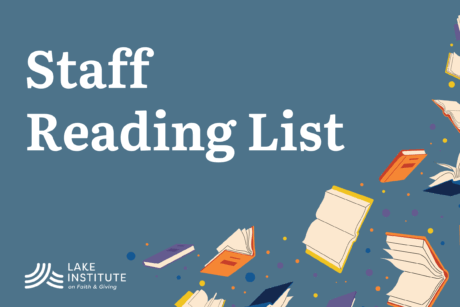 At Lake Institute, we often return to books both new and old as sources of insights, reflections, and challenge in both our professional and personal lives. Whether it’s reimagining generosity through nature, wrestling with faith and justice, or exploring the power of community, the books we read tend to reflect the questions we’re asking in our work and in the world.
At Lake Institute, we often return to books both new and old as sources of insights, reflections, and challenge in both our professional and personal lives. Whether it’s reimagining generosity through nature, wrestling with faith and justice, or exploring the power of community, the books we read tend to reflect the questions we’re asking in our work and in the world.
As summer winds down, a few members of our team wanted to share recent reads that have shaped their thinking and sparked meaningful conversations. We hope these recommendations do the same for you!
Webinar: The Latest Trends in Giving to Religion
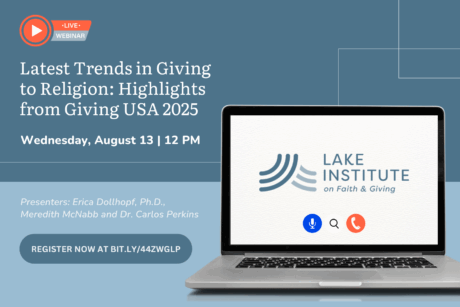 Join the Lake Institute team tomorrow, August 13 at 12:00 PM ET, for a Zoom webinar titled Latest Trends in Giving to Religion: Highlights from Giving USA 2025. Erica Dollhopf, PhD, Meredith McNabb, and Dr. Carlos Perkins will explore the newest data on religious giving and share key insights from the Giving USA 2025 report.
Join the Lake Institute team tomorrow, August 13 at 12:00 PM ET, for a Zoom webinar titled Latest Trends in Giving to Religion: Highlights from Giving USA 2025. Erica Dollhopf, PhD, Meredith McNabb, and Dr. Carlos Perkins will explore the newest data on religious giving and share key insights from the Giving USA 2025 report.
Subscribe
Insights is a bi-weekly e-newsletter for the religious community and fundraisers of faith-based organizations that provides:
- Reflections on important developments in the field of faith and giving
- Recommended books, studies and articles
- Upcoming Lake Institute events

